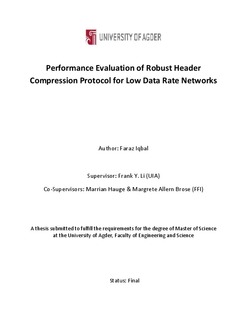| dc.description.abstract | Mobile Ad hoc networks (MANETs) have limited capacity due to properties of the physical medium for
tactical operations. Several traffic types are typical for tactical applications, i.e. transmit frequent short
IP packets (e.g., VoIP and friendly force tracking message). The RTP, TCP/UDP and IP headers comprise a
significant overhead for these traffic types. Therefore, robust header compression (ROHC) protocol can
useful to save the bandwidth for such applications.
This thesis work is divided into two tasks. First one is the technological background of the robust header
compression (ROHC) protocol. Furthermore, a brief introduction and comparison of the related research
work which has been performed for header compression in MANETs.
Second task is a real-life testbed scenario where a hybrid wired channel is emulated with loss or delay
which is caused by an imperfect wireless channel for a single hop case. Traffic source (compressor node)
and bridge node emulation approaches are proposed for channel emulation. Additionally, Netem
(network emulator) is used as emulation tool for these approaches.
ROHC protocol performance is evaluated over bridge node emulation testbed scenario. Vyatta Linux
routers are already integrated with ROHC library and perform the compression and de-compression
functions respectively. The performance of the ROHC protocol is assessed in terms of robustness against
transmission errors.
Finally, we concluded that robust header compression (ROHC) protocol is robust up to 40% channel loss
for independent packet loss pattern. On the other hand, burst/consecutive packet pattern interrupts the
ROHC operation when channel loss is equal to or more than 20%. Additionally, it is observed that ROHC
protocol fails to de-compress the header at de-compressor end when consecutive packet loss duration is
equal to or more than 30 seconds.
Consequently, ROHC is very robust therefore it can useful for MANETS header compression where the
delay ranges from milliseconds to seconds. Furthermore, it is also effective for satellite communication
which has longer channel delay and RTT. | no_NO |
